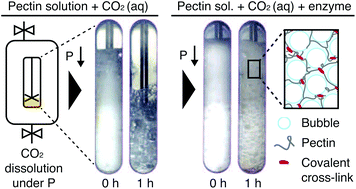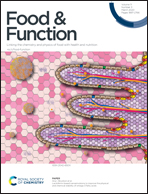Enzymatic cross-linking of pectin in a high-pressure foaming process
Abstract
The enzyme laccase is a copper-containing oxidoreductase with the ability to oxidize a wide range of substrates, such as ferulic acid. Thus, the ferulic acid-containing sugar beet pectin (SBP) can be cross-linked through laccase-mediated oxidation. As cross-linking increases viscosity, it could be applied to stabilize SBP-containing foams. In this study, laccase-mediated cross-linking of SBP was investigated under conditions of a high-pressure foaming process. Shear, presence of CO2, and pressure were simulated in a rheometer equipped with a high-pressure cell. At rest, addition of laccase to SBP solution led to the formation of a stiff gel. Application of shear upon mixing of laccase and SBP solution decreased the storage modulus with increasing shear duration and shear rate. This can be attributed to the formation of a fluid gel. However, when shear was stopped before all available ferulic acid groups were cross-linked, a stronger and more coherent network was formed. Pressure exerted by CO2 did not affect cross-linking. Additionally, this approach was tested in a stirred high-pressure vessel where SBP was foamed through CO2 dissolution under pressure and shear followed by controlled pressure release. While pure SBP foam was highly unstable, addition of laccase decelerated collapse. Highest stability was reached when laccase and SBP were mixed prior to depressurization. At the point of foam formation, the continuous phase was thereby viscous enough to increase foam stability. At the same time, continuation of cross-linking at rest caused gel templating of the foam structure.

- This article is part of the themed collections: Food & Function Recent HOT articles and Food & Function Recent Open Access Articles


 Please wait while we load your content...
Please wait while we load your content...